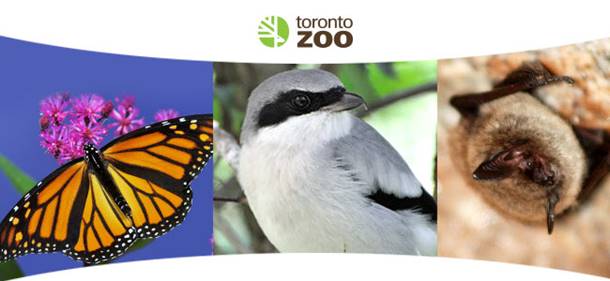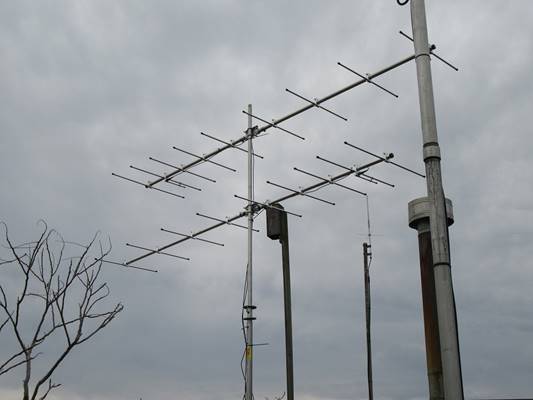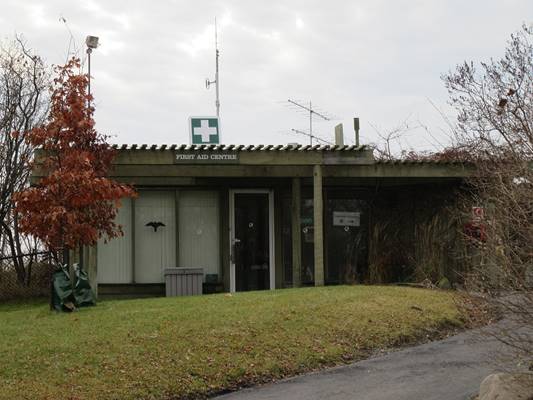
TORONTO ZOO IS PROUD TO BE FIRST ZOO IN CANADA TO
JOIN EXCITING NEW TECHNOLOGICAL PROGRAM FOR TRACKING
WILD ANIMAL MIGRATION

Motus Receiver Station Pictured Above, Photo Credit: Toronto Zoo

Motus Receiver Station Pictured Above Located On Roof Zoo’s First Aid Centre, Photo Credit: Toronto Zoo
TORONTO, ON, Wednesday, December 6, 2017 - On Thursday, November 30, 2017 the Toronto Zoo became the first Zoo in Canada, and only the second Zoo globally, to install a Motus Wildlife Tracking System receiver station on site, allowing the Zoo to assist in important migratory bird research. The Motus receiver station, which looks like a TV antenna, was installed on top of the Zoo’s First Aid Centre and currently reaches six metres in height, though there are plans to extend the tower to 15 metres in 2018. Motus enables researchers to track the movements of birds, bats, and other highly mobile animals as they travel over vast distances. The results can help us pinpoint threats to vulnerable species, identify priority habitats and conservation actions, and direct future efforts and funds for maximum impact.
The Motus Wildlife Tracking System is an innovative international collaborative research program that was pioneered in Canada. Researchers fit lightweight radio-transmitters, also known as a NanoTag, on migratory animals such as birds, and their signal is detected by receiver stations scattered across the landscape, which then communicate their detections to a central database located in southern Ontario. As each NanoTag for a bird can weigh as little as 0.25 grams and has a unique emission signature, they can track where individual animals go, how fast they transit between points (i.e. migration ecology) and how long they stay in an area (i.e. stop-over ecology). There are more than 350 receiving stations active across the Western Hemisphere, which can track tagged animals from Hudson Bay to South America.
“We are thrilled to be contributing data to this important endeavor,” says Dr. Kevin Kerr, Curator of Bird and Invertebrates, Toronto Zoo. “We intentionally installed the station in a location that would be highly visible to our visitors so that we could use this as an opportunity for outreach. It showcases an innovative research program that started in Canada and hopefully it will remind us that many of our native species travel far beyond our borders; protecting local wildlife sometimes requires a global perspective.”
Motus’ central objective is to enable conservation and ecological research by providing a way to track the movement of migratory animals; such as swallows, warblers, thrushes, shorebirds, bats, and even butterflies. NanoTags have also been deployed on eastern loggerhead shrikes, which is a species the Toronto Zoo supports in Ontario through a conservation breeding program.
Bird Studies Canada has been monitoring migrating birds since 1960 at the Long Point Bird Observatory. As technologies improve, so do methods of studying bird movements. The Motus Wildlife Tracking System, a program of Bird Studies Canada and their research partners, is the latest tool for researchers studying migratory birds and other animals and is already yielding exciting new insights. So far, nearly 100 species have been tagged for tracking.
Toronto Zoo Is Committed To Bird Conservation
Annual Winter Bird Count
The Winter Bird Count in the Rouge, hosted by partners Parks Canada and Toronto Zoo, takes place annually in January. Each year for this event, groups of keen participants are lead through various sectors of the Rouge Park by expert bird leaders and tally each species of bird they encounter.
The Toronto Zoo site itself constitutes one such sector, so some participants look for birds in the naturalized areas on the Zoo grounds. The event wraps up with all participants gathering data together while the birds are tallied from all of the sectors. Data from this count help inform experts about the birds using the area during the winter months and can provide good insight into trends and conservation strategies when compared across different years.
International Migratory Bird Day
The Toronto Zoo is committed to migratory bird conservation. The Zoo and Parks Canada annually coordinate International Migratory Bird Day in May highlighting and celebrating the migration of nearly 350 species of migratory birds between nesting habitats in North America and non-breeding grounds in Latin America, Mexico, and the Caribbean. International Migratory Bird Day is held at the Zoo and is celebrated with interactive exhibits, bird banding demonstrations and special events to introduce visitors to North American songbirds. Events like these show visitors that birds are an important part of our world and help demonstrate why birds matter.
Katie Gray, Supervisor of Public Relations and Events
[email protected] or #416-392-5941
Amanda Chambers, Public Relations and Events Associate
[email protected] or #416-392-5974
